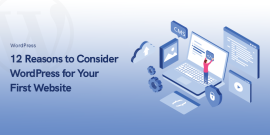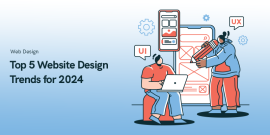Mobile Banking Apps in WordPress: 7 Tricky Tips for Customizing User Interfaces
The first thing you need to know about your mobile banking app is that it has to be a responsive website. What does this mean?
It means that your site should look good on any device, from small mobile devices like smartphones and tablets, all the way up to big desktop machines.
This is important because most people who access their bank accounts online use mobile devices more often than desktop computers.
In some cases, you might want different wording or images depending on what device someone is using (such as using a larger image on desktops than on phones).
To do this, we can add conditional code in our code snippets so that they only run when certain conditions are met (such as when the browser window width is less than 1024 pixels). This is called “responsive design,” and it’s very common in modern websites.
Banking is an industry that has been around for hundreds of years. It has evolved with the times and now encompasses everything from traditional brick and mortar banks to online banking and everything in between.
The way people communicate, interact and transact has changed dramatically over the past several decades. In order to stay relevant in this ever-changing landscape, banks need websites that reflect their current state of operations as well as their future aspirations.
The Role of WordPress in Banking
WordPress is a great platform for building websites, and it's used by many banks. WordPress has good security, is easy to use, and flexible enough to meet the needs of most projects.
With the ongoing digitalization of the banking industry, WordPress powers over 26% of the web (according to W3Techs), making it an ideal choice.
That's a lot of sites! It's also used by many financial services companies like PayPal or Square who want their customers' experiences with them online to be pleasant and secure and that's why they've chosen WordPress as their CMS platform.
In fact, there are literally thousands of ecommerce stores running on this content management system as well!
Choosing the Right WordPress Theme and Plugins
When you're building a WordPress website, you'll need to choose between two main categories of themes: free and premium.
Free WordPress themes are available from the WordPress theme repository, but they have limitations in terms of the features they offer. Premium themes cost money and typically have more customization options than free ones do.
When choosing a theme for your banking site, consider what features it offers because this will determine how easy or difficult it is to customize your site after launch.
For example, if you want to change some colors or fonts on your site without coding experience then choosing an easy-to-use theme will save time and money later down the line when updating content becomes necessary (which happens often).
You'll also want to make sure that any premium theme you purchase includes security measures such as SSL certificates so that visitors feel safe entering their financial info online!
Customization and Branding for Banking Websites
Customization and branding are the key to creating a website that is truly unique. Customization refers to the modification of the theme, plugins, or other elements of your WordPress website.
Branding involves customizing anything from colors and fonts to images used in your logo or on other pages of your site.
This process can be as simple as changing some text on an existing page or much more involved; it depends on what you want from your new site!
While customization may seem like an easy task at first glance (and often times it is), there are many aspects that need careful consideration before making any changes with regard to how they will affect users' experiences when interacting with their banking website. Some examples include:
- Changing existing headers/footers on all pages within a theme can cause problems if not done correctly because there could be conflicts between different scripts running simultaneously within one page load sequence which could cause errors in how JavaScript functions behave during normal operations (e.g., logging into online banking accounts).
- Adding new content blocks requires knowledge about how best practices work within WordPress CMS environments so we don't accidentally break things by adding too many customizations at once without testing them first beforehand.
Security Considerations in WordPress Development
While WordPress is secure by default, you still need to take some precautions.
The first step is to use a strong password and keep it updated. You should also install one or more security plugins such as Wordfence or Sucuri Security.
These are available from the WordPress Plugin Repository and are free for all users of WordPress (including free versions).
These will help protect your site against malware, spam comments and brute force attacks on login pages etc., which could otherwise cause serious problems for your business if they were successful in gaining access to sensitive information such as customer passwords or personal details about staff members.
You should also consider installing firewall software on all computers used by staff members who work with sensitive data online – this will prevent unauthorized access from outside sources such as hackers trying to gain entry into servers through vulnerable ports within networks; plus firewalls can easily be configured so that once installed they run silently in background mode without needing any further input from system administrators – making them ideal for businesses where time is money!
Integrating Banking Features and Services
Once you have the framework for your WordPress website development project in place, it's time to start integrating the banking features and services that will make your site unique.
Payment Processing
This is one of the most important features on any eCommerce site because it allows customers to pay with their credit cards. There are multiple options available when it comes to payment processing, including Stripe and PayPal Payflow Pro (formerly Authorize.Net).
Customer Support
Customers want easy access to customer support whenever they need it and they'll go elsewhere if they don't get what they want quickly enough!
If you're looking for an effective way of providing 24/7 customer service via live chat or phone calls, try Olark or LiveChat UK instead; both offer free trials so that you can test them out before making a commitment.
Accounting Integration
Accounting software like Quickbooks Online makes managing financial data easier than ever before by connecting directly with your bank accounts through API integration.
Security Checks
Banks require strict security measures when developing new applications because sensitive data must always be protected from hackers trying their best at breaking into systems through brute force attacks.
User Experience (UX) and User Interface (UI) Design
UX and UI are inseparable. In order to create an effective website, you need both UX and UI design.
They are both equally important for a good user experience, which is critical in banking websites because they need to be easy and intuitive enough for people who aren't tech-savvy or have never used online banking before.
User Experience Design (UX) focuses on how people interact with your website, what they do on it, how long they stay there, what tasks they complete first and so forth.
User Interface Design (UI) focuses on how a website looks: color schemes; font choices; buttons or links being placed at the top left corner instead of somewhere else on the page; etcetera The two should work together seamlessly so that no matter where someone clicks/taps/scrolls on your site it feels natural and intuitive rather than confusingly placed or unintuitively designed.
Performance Optimization for Banking Websites
WordPress is a great platform for performance optimization. It comes with a variety of features that help you to improve your website's loading speed, such as:
- WordPress caching – Caching allows you to serve content faster by storing it in the database, which reduces load times on subsequent visits by eliminating the need for each visitor's browser to resend requests and receive new content every time they visit your site.
- WordPress minification – Minification refers to removing unnecessary characters from code while leaving its functionality intact; this makes files smaller so they load faster over HTTP/1 connections (i.e., most web browsers).
- CDN integration – CDNs (Content Delivery Networks) are networks of servers around the world that store copies of popular files such as JavaScript libraries, CSS stylesheets and images that can be accessed by anyone visiting any one of these servers instead of having them sent from one server at one location only which might otherwise result in slower delivery times due to congestion issues caused by high traffic volumes being concentrated onto one physical server alone!
Compliance and Regulatory Considerations
Compliance is a term used to describe the process of ensuring that you are in compliance with the regulations that apply to your business.
There are many different types of regulations, but they all serve the same purpose: they make sure that everyone follows certain rules so that things work well for everyone involved.
The most common types of regulations include banking, accounting, tax and privacy laws. Banks must follow these rules because they deal with other people's money – if they don't follow them properly then it could cause problems for their customers or even make them lose money!
Regulatory authorities exist because there are so many different types of businesses out there – if one person was responsible for making sure everything was done correctly then it would be impossible!
Instead we have lots (and lots) of different organizations who each have responsibility over different areas – this helps ensure consistency across all industries which makes life easier for everyone involved.
WordPress is a great CMS for any business, but it's especially good for banking and financial services. It offers the features you need to grow your business, plus it's easy to use and maintain with built-in security measures that keep your website safe from hackers.
If you're looking for a site builder that will allow you to create an online presence without having to pay an arm and leg in fees, then look no further than WordPress!
Mobile Banking Apps in WordPress
Mobile banking apps have become increasingly popular in recent years, providing users with a convenient and accessible way to manage their finances on the go.
WordPress, as a widely used content management system, offers many options for integrating mobile banking features into websites and apps.
With the help of plugins and custom development, WordPress sites can offer a range of mobile banking functions, including account management, mobile check deposit, bill payment, and money transfers.
These features can help banks and financial institutions improve their customer experience and stay competitive in a rapidly evolving digital landscape.
However, it's important to ensure that proper security measures are in place to protect sensitive financial information and prevent fraud.
Understanding User Interface Customization in WordPress
The WordPress Customizer is a powerful tool that allows you to customize your theme, widgets and other parts of your site. It's easy to use and has been designed with beginners in mind.
The Customizer has three different views: live preview (also known as “the frontend”), static preview (also known as “the backend”) and fullscreen mode.
Each mode allows you to make changes without affecting your live site until you're ready for them to take effect.
In this article we'll focus on using the live preview mode which gives us an idea of how our changes will look once published online.
Planning the User Interface Design
A user interface (UI) is the means by which users interact with your app. It consists of all the elements that make up your design, including buttons, menus and icons.
A user interface design is how you lay out these elements so that they're easy for people to use and this can differ depending on who you're designing for:
- The general public may prefer an intuitive layout where everything feels familiar and easy to find. For example, putting “Log Out” at the top-right corner makes sense because most people read from left-to-right when using mobile phones or tablets; thus this placement keeps them from having to scroll down before they can log off their accounts if they forget their password (which happens often).
- Users with disabilities might have different needs than those without disabilities do; for example: someone who has low vision might need larger text sizes than normal so as not to miss any important information while reading through forms or emails sent during business hours while everyone else takes time off work during summer vacations… You get the idea!
Customizing UI Elements in WordPress
Now that you've got the basics down, it's time to get into the nitty-gritty of customizing your WordPress site. To do this, we'll be using the Customizer in WordPress.
- Headers and footers are easy to customize just click on “Header” or “Footer” in the left sidebar of your customizer panel and then click on any section of either one that has been modified. You can also add new sections here if necessary!
- The login screen has been completely redesigned for mobile banking apps and it looks great! If you want to change how users log into their accounts from their phones or tablets, just click on “Login Screen” under Appearance > Customize (you may need to scroll down).
Responsive Design for Mobile Devices
Responsive design is the process of creating a website or application that can adapt to different screen sizes. The goal is to make sure your website looks good on any device, from desktop computers to mobile phones and tablets.
The advantages of responsive web design are many:
- Your site will be accessible from any device, regardless of screen size or resolution.
- You'll be able to optimize content for each device type without having multiple versions of your site (which would be very expensive).
- Visitors will have an easier time reading text because it will fit naturally into whatever space they have available, no zooming required!
Accessibility and Usability Considerations
Accessibility and usability are important considerations for mobile banking apps.
- The user's ability to see and hear: Make sure that the content is easy to read and understand, even with small font sizes or low resolution screens. Use images instead of text where appropriate, and make sure your app doesn't rely solely on audio or video for information delivery (for example, if you have a voiceover as part of your app's sign-up process).
- The user's ability to use their device: Consider how someone who may be unfamiliar with smartphone technology might use it for example, by having them tap buttons with one hand while holding something in another hand (like groceries). You should also consider whether people can navigate through menus using only their thumbs; if so, make sure there aren't any long lists that scroll horizontally across multiple pages!
- Language considerations: If your target audience speaks multiple languages fluently (or at least one), consider providing options for different languages within each screen so users don't get stuck without being able to understand what they're seeing on screen.
Testing and Iteration
Testing and iteration are two important processes that you should keep in mind when customizing your banking app's user interface.
Testing is about finding bugs, while iteration is about improving the product. You can test a WordPress theme using automated tools like WP Theme Unit Test or manually by using Chrome Developer Tools or Firefox's Firebug add-on.
These tools will help you identify any issues with your code so they can be fixed before launching an app on production servers. For more information on mobile banking app development, visit website.
In addition to testing at every stage of development, it's also important for developers to monitor their apps post-launch by tracking user behavior with analytics tools like Google Analytics (GA) or Kissmetrics so they can see whether changes made during iterations improve or worsen user experience over time.
You can create a custom user interface for mobile banking apps
You can create a custom user interface for mobile banking apps in WordPress.
In this article, we'll take a look at the following:
- How to customize the user interface of your mobile banking app.
- How to create a custom user interface for mobile banking apps.
Conclusion
With the right tools and a little planning, you can create a custom user interface for your banking app. The best thing about this approach is that it doesn't require any coding knowledge on your part.
You can use WordPress to customize all of the elements in your app's UI, including fonts and colors as well as images or videos.
Once everything looks exactly how you want it and works seamlessly across different devices you'll be ready for prime time!
Recommended Posts

Marketing Tactics for WordPress Excellence in 2024
January 22, 2024

12 Reasons to Consider WordPress for Your First Website in 2024
January 17, 2024

Top 5 Website Design Trends for 2024
January 8, 2024